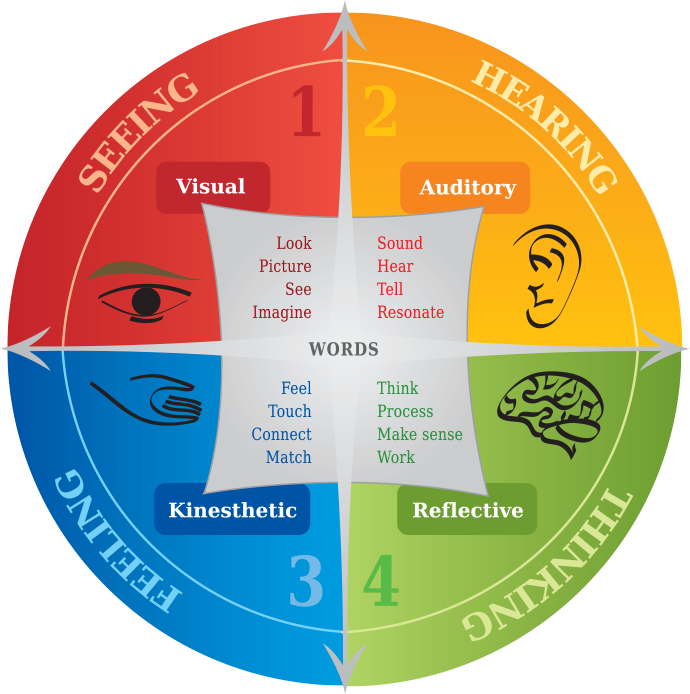
- Jun 7, 2021
Hearing Loss and Visual Learners
the myth and reality
Learner Characteristics
The concept of learner characteristics is used in the sciences of learning and cognition to designate a target group of learners and define those aspects of their self that may influence how and what they learn.
Learner characteristics can be personal, academic, social/emotional and/or cognitive in nature.
With respect to learner characteristics, there are often large differences between the characteristics of different learners and groups of learners such as children, students, professionals, adults, older people and disabled persons. These groups differ in their motivation, prior knowledge, expertise level, study time, and physical abilities.
Instructional designers constantly deal with new and differing groups of learners and thus must make decisions as to what characteristics of the target group are most important when tailoring instruction.
(Hendrik Drachsler, Paul A. Kirschner. Learner Characteristics. Centre for Learning Sciences and Technologies - Open University of the Netherlands, 2011.)
Learning strategies and styles are described in a range of ways. In the literature, while there are variations in the different learning style 'models', there are also many similarities.
One popular 'learning model' includes the following three learning styles:
- Visual
- Auditory
- Kinaesthetic

Learning Assumptions and Disability
Learning with a disability presents specific challenges for instructors and learners. However, some learning styles aimed at those with a disability are at times misdirected because they are based on assumptions rather than facts.
For instance, people who have a hearing loss are either pre-lingually deafened or post-lingually deafened. People who are pre-lingually deafened have lost their hearing before they acquired language. People who are post-lingually deafened acquired their hearing loss after they acquired language. For each group the impact of the hearing loss and the degree of deafness will vary as will the most effective learning style.
People with a hearing loss may use hearing aids that fit inside or behind the ear. While cochlear implants are surgically implanted devices that bypass the damaged inner ear and send signals directly to the auditory nerve. Therefore, new technologies are making it possible for larger numbers of hearing-impaired students to attend school and participate in activities with their hearing peers.
Deaf Culture
An estimated 10 per cent of the world's population is to some degree, deaf. That is, 700 million individuals, ranging from those who have mild hearing loss and may or may not rely on hearing aids or lip-reading, to those who communicate using sign language and are part of a diverse Deaf Culture.
Deaf Culture is a culture that is centred on sign language and relationships among one another. Unlike other cultures the Deaf Culture is not associated with any native land as it is a global culture. Deaf Culture sees itself as a language minority rather than a disability group.
Today, there is strong opposition within Deaf Cultures to the oralist method of teaching deaf children to speak and lip read with limited or no use of sign language in the classroom.
There have been many arguments about whether the manual method (where the teachers instruct the learning of Sign Language as the main way to communicate) or the Oral method (where the teachers make the student learn to speak) is better.

Most people now agree that the Manual Method is the preferred method of Deaf communication. The use of sign language is central to Deaf people as a cultural identity and any attempts to limit its use are currently viewed as an attack on Deaf Culture.
(from Hearing Loss in Australia – a brief hear story of deafness. Gration S. 2018 http://www.hearingadvice.com.au/Hearing-Aids/news/NewsArticle.jsp?News_ID=9 )

The Myth of Visual Learning
It is not uncommon for people to believe that individuals who are deaf can see better than people who can hear.
Although deaf students depend on vision more than their hearing peers, regardless of whether they use sign or spoken language, there is no evidence to indicate that they are more likely to be visual learners in (referred to as the sensory compensation hypothesis) or to be better visual learners than hearing individuals.
Research has found that over 40 % of the 110 deaf and hard-of-hearing (DHH) children examined in the study had one or more vision-related abnormalities, a prevalence 2 to 3 times greater than in hearing children (Guy et al. 2003).
The notion that deaf students are visual learners is sometimes equated with their reliance on sign language as opposed to spoken language.
Learning via sign language, however, is a verbal skill (as is reading) even if it depends on vision rather than voice. A preference for sign over speech as the language of instruction is not sufficient to make someone a visual learner.
(from What kind of learner are you? Gration S. 2019 https://www.hearingaidprices.com.au/Hearing-Aids/news/NewsArticle.jsp?News_ID=25 )
Further, despite the knowledge difficulties of deaf students with the skill of reading (Qi & Mitchell, 2012), recent studies have shown that deaf students from 12 years old through to university age, learn no more from sign language than they do from text[s].
"In short, deaf people generally do not see better than hearing people."
(Marc Marschark et al. Don’t assume deaf students are visual learners. 2016.)
Lip and Speech Reading
Most hearing-impaired students can lip-read and/or speech-read to some extent.
Technically, lip-reading is watching the lips of the speaker to extract whatever speech information one can. Speech-reading encompasses lip-reading. However, speech-reading is also watching the lips, tongue, teeth, cheeks, eyes, facial expressions, gestures, body language and anything else that gives clues as to what a person is saying.
To help hearing-impaired students to speech-read and lip-read, make sure to face them when talking to them and the rest of the class. Talk slowly and clearly and speak in a normal tone if they are using hearing devices or cochlear implants.

Advice for Teachers and Instructors
Students with hearing impairments may wear hearing aids, have cochlear implants, or use FM systems, which include a microphone/transmitter worn by the teacher and a receiver worn by the student. Therefore, it’s important to ensure that any background noise in the learning space or classroom is minimised for those using assistive hearing technologies.
Students with a hearing loss may also need to use other assistive technologies to participate in class; for example, where possible any viewing of videos or films should be captioned in real time.
A laptop where software such as Skype can be used to deliver Auslan interpreters (language of the Australian Deaf Community) or captioning is another form of assistive technology.
Students may also:
- need voice-recognition software on their computers, which can help with note-taking
- require speech therapy due to delayed speech or language development
- need to sit closer to the front of the class to speech-read or lip-read, or to hear more clearly
- need instructions repeated
(adapted from Kids Health - Hearing Impairments Fact Sheet (for Schools) 2018.)

While teaching or instructing, try not to turn your back or speak while writing on a board and consider arranging chairs in the classroom in a circle so hearing-impaired students can interact with classmates.
Teachers and instructors can encourage hearing-impaired students to participate in all classroom and extracurricular activities.
Advice for everyone with normal hearing
If you were aware of the issues experienced by people with hearing loss you would communicate differently.
Vision loss is corrected and is well understood. Hearing loss is not so simple, different scenarios (imagine if your glasses simply didn't work at night) cause issues for people with hearing loss.
With hearing aids it is not simply a matter of amplification.
Listening for a person with hearing loss is a lot of work, to the point of not being worth it in some cases with background noise.
Driving a Car and trying to hear
With the background noise of a car and the use of car speakers or hands free phone speakers of varying quality a person trying to conduct a conversation with someone with hearing loss should immediately check if they are comfortable with the conversation. If not cut it short and complete the conversation when you are in a location better suited.

Restaurant background noise and trying to hear
Forget having a good conversation with someone with hearing loss unless they are very close to you and can have face to face contact to pick up all of your conversation cues.
Even the way you frame a conversation matters. Ensure the listener has understood the main point of the conversation before launching into detail.
Age and trying to hear
Young people with normal ears may be able to fill in the blanks for the half words in rapid, often mumbled speech.
Older people do not process the blanks as well, or if they do cannot do it constantly without becoming fatigued.
Work environments and trying to hear
Until COVID 19 and the opportunity to work at home, many people were unaware of how a busy, often noisy work environment affected their productivity.
If you are trying to make a sale to a person with hearing loss forget that noisy call centre background. Combined with an unfamiliar accent that is hard to pick up and you can simply forget any chance of successful communication.
A bit of patience with a call centre employee may be worth the effort, they are often educated above their pay grade and may have had a tough day with irate customers who can't hear (understand) them.
Technology and trying to hear
Become an expert in researching quality sound technology.
There is a reason those headphones cost $3 and when compared to noise cancelling headphones at 100 times the price, you are going to hear nothing from the cheap set so check the reviews.
Not all products are good for people with hearing loss.
Assistive Technologies
To see what other assistive hearing technologies or teaching resources are available, check with a special education teacher, speech–language pathologist, or contact:
Hearing Advice http://www.hearingadvice.com.au/index.html
Hearing Aid Prices https://www.hearingaidprices.com.au/
Deaf Australia https://deafaustralia.org.au/information/resources/
Deafness Forum of Australia https://www.deafnessforum.org.au/resources/; and
Aussie Deaf Kids https://www.aussiedeafkids.org.au/resources.html
Researched, Compiled, Composed and Written by Dr Steven Gration - July 2019 SEO Gold Coast
References and Sources
http://www.hearingadvice.com.au/Hearing-Aids/news/NewsArticle.jsp?News_ID=9
https://www.hearingaidprices.com.au/Hearing-Aids/news/NewsArticle.jsp?News_ID=25
workreadytraining.com.au
kidshealth.org
ncbi.nlm.nih.gov
Browse Other Articles
The first site in Australia to list major brands of hearing aids and prices.